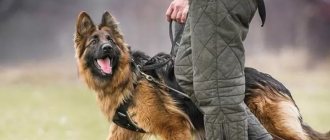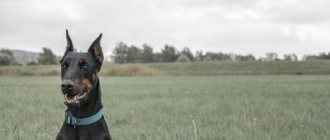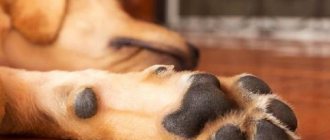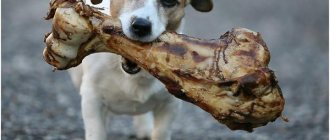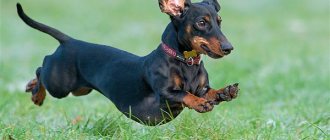Dobermans are a service breed that requires systematic and competent training. These dogs need the severity and authority of the owner, but not cruelty, so their upbringing should be under the supervision of an experienced dog handler.
With timely and correct training in commands, a Doberman puppy will grow up to be an affectionate and loyal dog, capable of protecting its owner.
Character and intelligence of Dobermans
The Doberman Pinscher is a service dog that retains protective qualities. At the same time, representatives of the breed should not show aggression towards humans and other animals for no reason. Dobermans are fearless and loyal - they are unlikely to leave their owner for a treat or a toy.
Dogs of this breed are very active and energetic, requiring appropriate physical activity. Animals are easy to train: Dobermans are very smart and quick-witted. In addition, pets are well-oriented and always ready to interact with their owner. As a rule, animals behave calmly at home, without imposing unnecessary attention on family members.
Caring for animals is easy. Dobermans are very friendly and welcoming. Of course, there are exceptions in the breed, but in most cases the angry, aggressive or fearful character is reinforced by the owner himself due to his illiteracy and lack of experience.
Is it possible to raise a Doberman?
Statistics on recognized breeds state that out of four hundred, only nine carry the official designation of a working dog. And the Doberman is included in this number.
Stanley Conor in his book “The Intelligence of Dogs” noted the excellent trainability of this breed. Therefore, the answer to the question is clear: yes, really. It’s just that the Doberman, like any other dog, requires an approach during training.
Since ancient times, this breed was intended for protection. That is, the dog’s task was to protect the owner and, if necessary, attack the enemy. Therefore, when training an animal, it is important to pacify its militant nature.
The main thing is to educate correctly and wisely.
Where to begin
Training a pet must begin with building a relationship with the owner and establishing motivation. To improve your bond with your animal, play with him more and have fun together. When a Doberman trusts the trainer, the work process begins to lead you to a positive result.
Do not scold your pet when he makes a mistake, but use positive reinforcement (treats or toys) to explain to him an alternative correct behavior.
How to motivate a Doberman to train?
- Offer food that is more palatable for your pet as a treat. For example, meat or offal;
- Don't just feed your dog. The dog must earn a bowl of food. Before feeding the animal, ask it to follow several commands or use the food as a reward for a full training session;
- start the lesson only when the Doberman is not full and full of energy. A well-fed and tired animal will not want to work. Moreover, with tedious activities you will only take away the dog’s desire to work;
- exercise often, but not for long. Short approaches will prevent the dog from feeling bored and tired;
- Praise your pet more often. Remember that emotionality also has a positive effect. Deliver your praise in a cheerful, cheerful, and energetic manner.
At what age should you start?
As a rule, from 3-16 weeks the puppy begins to actively explore the world around him, and from this moment his socialization and training begin, since this is an excellent time to come to an understanding of the person and an awareness of the situation in the house.
The pet learns gestures, begins to distinguish praise from blame, and learns to arrange logical chains in order to know in the future what reaction this or that action may cause.
At the age of 4 months, the puppy remembers everything perfectly. In addition, there is a distinction between dangerous and safe, so violence against an animal is unacceptable - the effectiveness of training has nothing to do with physical punishment.
Expert opinion
Kozhevin Semyon Kirillovich
Expert dog handler.
The Doberman was bred as a bodyguard dog, so it follows commands very well, but not if the owner is in real danger. Here the dog will make the decision itself. The Doberman is easy to train, but is also not averse to messing around if the lesson seems uninteresting. The main thing is to properly motivate the animal, influence it and encourage it to action, but this is a matter of individual preference. The Doberman easily makes contact using both the “stick” and the “carrot”.
When to start training and education?
As soon as the puppy arrives to you, after a couple of days, when he gets used to the new environment, you can already begin the first stages of training. Classes should be simple and take place in a playful way. The puppy does not need to be scolded or punished - this will only worsen your relationship with him. Training should be fun for both the puppy and you.
Difference between boys and girls
Differences depending on gender:
- The male is capable of showing excessive ardor, sometimes even becoming aggressive. Having noticed a stranger in the protected area, the dog immediately rushes, trying to drive out the enemy.
- The female has a different tactic. The dog starves out, keeping the emerging enemy at a distance. As soon as he tries to get closer, he starts growling.
Selecting a location
The first stages of Doberman training should take place in a calm and familiar place. A house or apartment is an ideal area for training, because it is there that the animal will not be distracted by extraneous stimuli.
If the Doberman already has some skills and interacts well with the owner, training can be carried out on the street. Of course, you shouldn’t immediately start studying in noisy and crowded places. Start working in a peaceful and quiet environment, gradually moving to places where there are more and more stimuli.
What can be taught?
The breed has successfully proven itself in many types of service and sports, so the last thing the owner should worry about is the range of activities of the dog.
Doberman Pinschers are predisposed to:
- search and rescue service;
- protective guard service;
- search (search for things, people, animals, prohibited means, etc.);
- protection of territories or property;
- “bodyguard dog” positions.
Dogs have a number of useful characteristics. Thanks to their sense of smell and intelligence, they are in demand at customs, serve in the police and at the border.
These animals are easily given OCD, so if the owner does not intend to build a career for the pet in official activities, then you can always give in to sports.
Animals demonstrate good learning ability in competitions in:
- canicross (musher dog);
- dog-pulling (tug-of-war);
- agility (speed overcoming barriers);
- frisbee dog (catching a flying disc);
- waitpulling (dragging a load over a certain distance);
- pitch-and-go (quick fetch offering);
- freestyle (a combination of obedience exercises and tricks to music);
- bike joring (a sledding sport where instead of a dog sled, dogs pull a bicycle);
- scooter (a type of snowless sport where the dog pulls the owner behind him on a scooter);
Doberman is without a doubt a worthy competitor in the fight for the main prize.
Choice of treats
The selection of treats is individual for each dog. You will have to experiment and offer the animal different variations of treats: meat and offal, cottage cheese, specialized dog treats, cheese (not recommended in large quantities).
As a rule, dogs prefer meat products most of all. Meat and offal can be given raw or cooked - at your discretion. It is more convenient to work with a boiled treat, but a raw treat will bring more vitamins to the animal’s body.
Dogs are still predators, and they are adapted to digest raw foods (perhaps with rare individual exceptions). The main thing is to buy quality products from trusted places.
The more smell the treat has, the more interested your pet will be in it. Choose a more fragrant type of meat or offal (not to be confused with rotten). In order to enhance the effect, you can cook the meat in water to which garlic has been added. After cooking, be sure to remove the garlic if it gets into pieces of meat. Such a treat is safe and more interesting for the animal due to the enhanced pungent odor.
We make the training process easier
Proper organization of training facilitates the process and guarantees results. Some tips for successful studying:
- Don't start training in a bad mood. The dog will sense this and the training will not be effective.
- Mastering new commands begins with 15 minutes, gradually increasing the training time.
- New commands are taught only by the owner or a dog trainer.
- It is necessary to adhere to the daily routine, it is especially necessary to strictly adhere to feeding and walking times.
- When walking, the owner always walks a little ahead, and the dog runs behind.
- You cannot feed a Doberman with food from the owner's table during lunch. The dog eats last, in a specially designated place and from its own bowl.
- Playing at inappropriate times should not be encouraged.
- Consistent and thoughtful parenting. If you let a dog tear apart his old slippers, he won’t understand why he shouldn’t chew new ones.
How to give a Doberman's ears the correct shape?
Basic commands in training
Basic skills include exercises that will be applicable in everyday life and will make your walks with your pet safer.
To me
Since the Doberman requires serious exercise, it will be easier to provide him with activity without a leash (of course, in areas that allow such walks). In order for a walk without a leash to be safe, you need to teach your dog the “come to me” command. Be sure to take treats with you when walking so that you can reward your animal for approaching you every time.
Stand
An important command for safe walks. It can be used in any emergency situations when you need to stop the dog or, for example, when simply crossing the road (stopping in front of a pedestrian crossing).
Ugh
On the street and at home, there are harmful or completely inedible foods for dogs to eat. Often, pets are interested in forbidden things and strive to eat them. The “fu” command will prevent an unpleasant action and save your animal from disappointing consequences in the form of health problems.
Sit
The “sit” command will make your life with your pet more comfortable. There are situations when you need to sit your dog down. For example, in front of a door to open it and calmly move on. The command is completely easy to train and does not require much strength or patience from the trainer.
Most common mistakes
Mistakes that Doberman owners most often make when training their pets:
- lack of an individual approach;
- there is no specific sequence in developing techniques and organizing training sessions;
- overtraining (overtiring the dog);
- using the wrong stimuli;
- underestimation of the impact of other irritants on the dog;
- abuse of a strict collar (parfors);
- erroneous intonation in the voice when issuing commands;
- repeated repetition of the command “Fu”;
- incorrect delivery of instructions;
- inappropriate encouragement.
OKD – general training course
Receiving the OKD standard will indicate that your dog has been trained in basic training skills and is well-mannered and safe for others. To pass the test, you must attend training courses or prepare yourself.
The OKD standard is not mandatory for execution. If the owner is interested in passing the OKD or any training organizations require a certificate of passing this standard, it is necessary to pass the test. Training and compliance with the OKD standard is a simple process, since the criteria are quite simple and loyal to more serious sports.
How to choose a puppy?
The future owner of a Doberman usually has an idea of what kind of dog he wants to see next to him. One needs an affectionate companion, and he chooses a female. Another person needs a strong and formidable protector and acquires a male dog.
They take the choice of a pet seriously. First, they decide on a nursery. You can also buy a puppy from friends who have bred at home. The baby will grow up to be a loyal friend, but mental problems may arise as an adult. A kennel that breeds several breeds of dogs is also not a good choice. In such a place it is difficult to pay due attention to the breeding of each of the breeds contained.
Doberman puppies
IMPORTANT! Experienced dog breeders choose specialized nurseries that select pairs to produce animals that retain the necessary qualities characteristic of purebred Dobermans.
But even for such nurseries there are some signs that you need to pay attention to.
Table 1. What to look for in a nursery when choosing a Doberman puppy?
| Sign or criterion for selecting a breeder | Fine | Badly |
| Place of birth of the puppy | The nursery that the future owner contacted | The puppy was brought from another place |
| Mother's age | Over 2 years old | Under 2 years old |
| How long ago did the mother have her previous litter? | No more than 1 year ago | More than 1 year ago |
| What is the litter size of the puppy's mother? | Fourth or more | Third or less |
| Documents for the puppy describing its health and breed information | Documents provided | Documents not provided |
| Documents for parents describing their health and breed information | Documents provided | Documents not provided |
| Photos of puppies from previous litters | Available. This means that the breeder maintains contact with his clients | No photos |
| Socialization | The puppy was given classes and accustomed to children and other animals. | A negative or vague answer indicates that the puppy has not been handled. |
| Condition in enclosures | Purely | Dirty |
You definitely should not take a puppy if the nursery has not provided documents or the baby was born in another place.
Signs to look out for when choosing a puppy:
- Exterior. The puppy must show signs of purebred: wide back and chest, strong bones, wide jaws, dark eyes, square body.
- Health. The baby should be active, with clear eyes, a good appetite, shiny coat and bright tan.
- Vices. Deformed limbs, light eyes, light spots on the coat are reasons to refuse the purchase.
Healthy puppy
ZKS - protective guard service
Training in defense is a more serious process than passing the OKD standard. Classes must be conducted with a canine handler. Otherwise, you will turn your dog into an aggressive and uncontrollable animal. ZKS requires a competent and responsible approach to business.
The dog is taught guard qualities, protection, control, and attentive listening to the owner. A properly trained defense dog can save you from intruders. In addition, training in ZKS skills makes the animal much more resilient and confident.
How much do dog handler services cost?
Let's consider the average cost of providing services with a dog handler visiting your home:
| Service | Price, rub |
| General training course (GTC) | 1700 |
| General obedience course (puppies) | 1700 |
| Behavior correction (aggression) | 200 |
| Managed City Dog (UGS) | 1700 |
| Training a dog for protection (ZKS) | 2000 |
| Group lessons (from 3 dogs) | 800 |
| Group classes on site (Course 10 lessons) | 8500 |
Socialization
It is necessary to socialize your pet from puppyhood. Show your puppy as many different places and objects as possible. Walk in noisy and crowded places to accustom your Doberman to society.
Ask passers-by and friends to come up and pet your puppy and give him treats so that he is not afraid of strangers. Do not exclude meeting other dogs - the pet must be able to communicate with its relatives.
If possible, travel with your dog on public transport, starting with short routes. Show your animal the whole diverse world around him. The more your dog knows and sees, the more confident he will feel on walks.
Behavior
Well-bred Dobermans are distinguished by their poise and sociable disposition, which contrasts with their stern appearance. Dogs are very loyal.
This is interesting: 10 most loyal dogs in the world
Such pets recognize only one person as the leader. Dobermans welcome other household members, but may neglect their demands.
Expert opinion
Anna Abramenko
An avid dog lover. Experience in veterinary medicine since 2009.
Ask a Question
The behavior of these large dogs clearly shows natural distrust and sometimes open aggression towards strangers. This must be taken into account when trying to avoid touching its owner in the presence of a Doberman.
Basics and stages of raising a puppy
2 months
At this age, it is important to teach the Doberman not so much commands as certain basic skills: following a hand with a treat, games, paying attention to the owner, eye contact. You can use treats to guide your puppy into the sit, down, and stay positions without using voice commands.
As for the educational process, you can show the puppy that there is no need to bite or jump on the owner. If the puppy bites you, pretend that you are hurt and go into another room. When the dog jumps on you, turn away from him and wait for him to sit down.
At this age, it is necessary to accustom the puppy to go to the toilet in a diaper, since quarantine is observed, and going outside is unsafe for health.
3 months
At the age of 3 months, you can gradually move on to learning simple commands and educational tricks. The tricks should be simple so as not to harm the animal: twisting around its axis, walking in a “snake” and “figure eight” between the legs, bowing, walking backwards.
Tricks are needed to physically develop the Doberman. With the help of such exercises, the dog learns balance, feeling his body and each limb separately. Well-developed coordination reduces the risk of injury while walking.
4-5 months
At the age of 4 months, you can gradually move on to activities outside, in the yard. Teach your puppy not to be distracted by others, but to stay focused on you. It is important to teach this skill to your pet so that it does not run away from you in the future.
Also, continue to study simple commands and developmental tricks. Train your puppy to use the toilet outside, gradually eliminating diapers from the house. Slowly teach your pet to stay home alone: first leave for 10 minutes, gradually increasing the time.
6 months
Teach your puppy more serious skills and commands: endurance, walking nearby, following commands from a distance. Of course, it is important to take into account that the pet is still a puppy - there is no need to demand execution of commands according to inflated criteria.
Command training
Training aimed at developing basic behavioral skills in a Doberman is a responsible undertaking. The smart pet learns quickly, but requires constant supervision.
The first sessions with the dog should last 10 minutes. Then the time period is gradually increased. From two months to one year, the dog is trained to perform basic commands:
- "Place!". In the hierarchy of education, this is one of the first skills acquired simultaneously with the perception of a nickname. The puppy becomes more disciplined. It is easier to observe him, controlling his location.
- "To me!". It assumes a trouble-free immediate approach to the owner. The command is carried out by voice or gesture. To develop the desired reaction, which is the main one for Dobermans, they use toys, treats for obedience, and approval.
- "Ugh!". From an early age, the puppy should be aware of what objects he is forbidden to touch.
- "Near!". This is one of the most difficult commands to practice regularly. They ensure that the dog takes a place to the left of the owner. The shoulder is located along the line of the person’s legs.
- "Sit!". “Lie down!”, “Stand!” The dog is trained to maintain the specified position for the time allotted by the owner.
- “Aport!” Skills are developed when organizing gaming activities. It is necessary to encourage your pet to run after a thrown object, pick it up, and then bring it back.
Raising an adult dog
If the moment of raising a Doberman is missed during puppyhood, it will be more difficult to correct the behavior of an adult dog, since it already has certain habits.
Raising an adult dog requires persistence and patience. Of course, you should not yell at your pet or use violence. It is necessary to find an approach that will be applicable specifically to your dog: some need a tougher and stricter owner, while others, on the contrary, need a soft and calm one. Training is carried out individually in connection with the qualities, abilities and character of a particular dog.
How to become an authority for a dog?
Hierarchy is a matter of time. If the owner is not interested in the position of leader, then the dog will take it. This is explained by the animal’s desire to live in a pack, where one of the individuals performs the duties of a leader and serves as a symbol of security.
A guide for beginner “two-legged leaders”:
- Set certain boundaries about what is allowed, whether it is regarding food or where to sleep. Do not follow the pet’s lead in his attempt to beg something from the master’s table;
- Do not allow your dog to enter your area (bedroom) without permission. And in relation to a neutral area (such as a living room), climb onto the niche first (sofa, armchair);
- Approval and censure follow the action. Don't punish an animal without reason;
- Stop aggression;
- Don't poison your dog on others for fun. The leader reacts only to a real threat;
- The right to decide when it is time to play rests with the owner;
- When you return home, do not let your dog get ahead of itself. The owner is the first to enter the house, and only after that the four-legged friend;
- Do not panic in the company of a pet (squealing, fussing). Dogs are sensitive to behavior changes.
Reward and Punishment
To achieve success in training and education, it is necessary to reward the animal and, in some cases, apply punishment.
Types of incentives:
- Reward with a treat. The most common way of praise among dog lovers. In this way, the Doberman can be quickly and clearly praised for the correct action.
- Game encouragement. There are play dogs who prefer play to treats or who love everything. Praising a dog with a toy is more difficult and takes longer than with food, but if the Doberman prefers this kind of encouragement, then the results will only be achieved with the help of it.
- Encouragement with attention from the owner. Dobermans need emotional praise from their owner. In some cases, attention is even more important for pets than a treat or toy.
What are the punishments?
Violent punishment should not be used against animals. In some cases, raising the tone is allowed, but only when you are sure that the dog understands why you are punishing him. As a rule, the most effective method of punishment is ignoring.
For example, if a Doberman starts jumping on you and tearing your clothes, ignore, turn around and walk away - in the future the dog will seek attention from you in more humane ways.
Character of the breed
The docked tail and ears give the Doberman a stern look. However, in its natural, natural appearance one can discern a good-natured disposition. Dobermans love their owners. They are affectionate with family members, but for proper training it is important that the dog obeys only one person in the house.
Despite this behavior with “their own”, Dobermans are distrustful of strangers. And this can result in open aggression.
If the pet perceives the stranger’s gestures as threatening, the attack will not be long in coming. Moreover, even a harmless pat on the shoulder can be taken as a threat. On an instinctive level, the beast always protects the pack family.
The attitude towards other animals can be easily adjusted during training.
The breed is suitable for security and search activities, sports competitions, and also for keeping as a pet.
Typically, Doberman Pinschers have the following traits:
- energy (which needs to be directed in the right direction);
- learning ability;
- vigilance.
These are smart dogs with good health. However, they tend to howl and bark if left alone at home. Therefore, the puppy must initially be accustomed to the fact that sometimes he will spend time alone.
There are two periods when the pet “tests the owner’s strength.” These are ages 3 and 8 months. This happens because under natural conditions the dog lives in a pack, where it is necessary to fight for leadership.
Important! All of the listed properties relate to the general characteristics of the breed. Each dog is individual and may differ in character from its peers. At the same time, Dobermans have mental illnesses that are inherited. Therefore, it is initially important to choose a breeder wisely.
Briefly about the main thing
- Dobermans are guard dogs that are friendly and loyal to their owners.
- Dogs of this breed are well-oriented and easy to train.
- You can train a Doberman from the age when he came to you and got used to it.
- Choose a quiet place to practice.
- Choose the most delicious treat
- Start your workouts with short sets, doing simple exercises.
- Increase the duration and complexity of training as your puppy ages.
- If you wish, you can take training more seriously by passing the OKD and ZKS tests.
- Try to train your Doberman on positive reinforcement with treats, toys and emotional praise.
ZKS - special training for the guarding qualities of a dog
After completing the general training course, the owner determines his further actions in relation to the dog. The dog is already fully socialized and can be a loyal friend to its owners. But the Doberman is capable of more, so the owner often chooses to further train and train him. One of these courses is ZKS. The peculiarities of protective guard service are taught from the age of one. Dobermans who have passed a stress test are allowed for training.
During protective guard service training, the dog is taught:
- Protect yourself from blows.
- Pursue the enemy.
- Recognize dangerous objects.
- Control aggression.
IMPORTANT! The course is aimed at protecting one’s own life and the life of the owners; attacks are not taught in class.
Classes on ZKS
4-5 months
As soon as the animal masters the priority rules of behavior, it can do without the control of its owner. It is strictly forbidden to allow disobedience, even during the game. When raising and training a Doberman, you should use persistence without humiliating your pet. The training process must be enjoyable for pets and owners.
Photo from Instagram account thedobermanpage
At the age of four months, the Doberman can move next to its owner, returning to him on demand. The dog is able to maintain a given position for a long time: stand, lie, sit. The puppy must be taught to ignore tidbits lying on the ground.
6-12 months
At six months, the dog begins puberty, so a rebel appears in the house. At this point, the puppy again explores the concepts of good and bad, and the owner's patience is tested. The pet no longer responds to the orders of its owner; it can pretend that it is bored, testing its reaction to pampering.
Photo from Instagram account electra.doberman
It is important to immediately respond to rebellion and point it out to your pet, but only without cruelty. At this point, all the shortcomings will become visible, so errors will have to be corrected immediately. A six-month-old animal must be taken to professional training classes. Training is carried out individually or in a group according to the general training course system developed in the Russian Federation. For a Doberman, taking a general training course turns out to be beneficial. He disciplines the pet, sets limits on what is permitted, and ensures obedience even in unusual conditions. The training ends with receiving an OKD diploma and the opportunity to work as a bodyguard.
What to feed a Doberman
One of the most important aspects of keeping a Doberman is proper feeding. The diet of a pet must be carefully thought out.
Note! You can feed a Doberman with both industrial food and natural food. But giving food from the common table is strictly prohibited.
As for dry food, you need to be prepared to try several brands at once, since this breed is a very picky eater. But you should still give preference to premium varieties; as a rule, they do not contain components that cause allergic reactions.
An adult dog needs at least 500 grams of meat per day
If preference is given to natural products, then the dog’s diet must include:
- lean meat in the form of lamb, beef, offal;
- vegetables – carrots, cabbage;
- cereals, it can be oats, buckwheat, rice;
- fermented milk products;
- fresh fruits, with the exception of citruses.
The daily dose directly depends on the load the pet receives. This issue is approached privately. But usually, for a one-year-old pet, 700-800 g of meat, about 500 g of cereals, and the same amount of vegetables or fruits are enough.
Like any other breed, the Doberman has its pros and cons. The character of the dog is unique, so it needs some training. Otherwise, the Doberman will cause a lot of trouble at home. He will bark loudly at any sounds, spoil things and behave unpredictably.
Basic mistakes and advice from a dog handler.
If you are not confident in your abilities, you can send your dog to a training camp. Listen to the advice of dog handlers to avoid basic mistakes:
- do not feed from the table;
- first learning, then playing;
- teach always and everywhere;
- adhere to the same line of dog education for all family members;
- positive motivation and encouragement;
- Avoid physical punishment.
Keep an eye on your pet, devote time to it and be sure to seek help from experienced specialists.
conclusions
If you haven’t changed your mind about getting a Doberman, consider the following points:
- Most stories about aggressive bloodthirstiness are special cases or deviations provoked by improper upbringing. With proper work with the dog, it grows into a balanced and extremely obedient pet.
- Leaving a Doberman alone with children is allowed only after special training under the guidance of an experienced dog handler.
- Puppies are ready to learn primitive commands already at three months of age.
- Carefully monitor your dog's health - decades of selective breeding have not saved them from many genetic and hereditary diseases.
- Guarantee your four-legged friend daily physical activity, and he will only be grateful for it.
- Nutritional plans must be coordinated with a veterinarian due to the high risk of allergies.
Sources
- https://vplate.ru/sobaki/doberman/
- https://pet-master.ru/sobachi-porody/dressirovka-dobermana.html
- https://www.vetkursk.ru/korm/dressirovka-dobermana-v-domashnih-usloviyah-dlya-nachinayushhih-po-mesyatsam.html
- https://lapkovskiy.ru/sovety/dressirovka-dobermana-v-domashnih-usloviyah/
- https://DogBuldog.ru/sobaki/porody/dressirovka-dobermana-3414/
- https://glorypets.ru/sobaki/dressirovka-sobak/dressirovka-dobermana-v-domashnih-usloviyah-dlya-nachinayushhih
- https://glorypets.ru/sobaki/porody-sobak/doberman-v-kvartire-soderzhanie-i-uhod-za-sobakoj
- https://zen.yandex.ru/media/gavkusha/kak-dressirovat-dobermana-v-domashnih-usloviiah-5ba08df159419200ab742c07
- https://4lapy.ru/articles/doberman/
Born to protect: origin and brief description of the breed
The Dobermann was bred by the tax collector Karl Friedrich Louis Dobermann at the end of the 19th century. Since he had to constantly carry large sums of money with him, he tried to create the ideal guard and protector.
The breeder specifically selected aggressive dogs of medium size. Today, Dobermans have the blood of butcher dogs, black and tan terriers, Old German Pinscher, French Shepherd and Weimaraner in their veins.
The Doberman is a large, smooth-haired dog. He is characterized by high intelligence, strength, endurance and strong protective instincts. The pet is balanced, non-aggressive, self-confident. However, only under the condition of a good genotype and proper upbringing.
Dealing with animals is not easy. Any mistakes in upbringing will affect the character and behavior of the pet.
Inexperienced owners scold Dobermans. They attribute to them uncontrollability, aggression, cruelty. However, dogs only become like this if they are not properly cared for. A healthy, well-mannered, socialized, mentally balanced animal is infinitely devoted to its owner, tries to please him in everything, and obeys immediately.
Caring for a Doberman in an apartment
Keeping a Doberman in an apartment involves not only providing the pet with the necessary conditions for a comfortable existence, but also proper care. In addition to regular visits to the veterinary clinic, it is necessary to carry out hygiene procedures in the form of washing, combing the fur and a number of other activities.
It is recommended to bathe your pet once every 10-15 days, so as not to reduce the protective properties of the skin.
Grooming
Before getting a dog, you need to find out what kind of care the Doberman breed requires. In addition to standard procedures, your pet needs regular brushing of its coat.
For the procedure, you will need a brush made from natural hair, and you also need suede cloth. Cleaning is carried out in a circular motion along the hair growth, as well as against it. After combing, wipe the fur with a damp cloth, this will help get rid of excess hair and dandruff.
Claws, teeth, ears
Experienced dog handlers give several recommendations on how to care for a Doberman. These tips are as follows:
- Your pet's nails should be trimmed as they grow, but at least once a month. The pet’s gait and the load on the joints will depend on this. In addition, overgrown claws can easily injure the blood vessels that grow along with the nail. It is best to teach this procedure from childhood. To trim claws, it is worth purchasing a special tool - a nail clipper; it must be strong enough and have a limiter.
- You need to clean your ears once every 7-10 days. The procedure is carried out using a special lotion and a cotton pad.
- Cleaning the mouth and teeth is carried out in order to avoid the appearance of plaque and tartar, which cause an unpleasant odor and also contribute to tooth loss. It is necessary to regularly examine the oral cavity and clean it using a special paste for dogs. Also, as a preventive measure, the pet is given a bone from the veins.
Nails are trimmed using a nail clipper; only the keratinized tissue needs to be removed.
As for bathing, water procedures are carried out as the coat becomes dirty, but this is done no more than three times a month.
Important! Frequent washing can lead to the skin's protective functions being impaired. You should be accustomed to washing from childhood.
Cupping
Cupping is carried out in puppyhood, before reaching three months. As an adult, it will be much more difficult for your pet to cope with the load, and surgical sutures will take longer to heal.
The procedure should be performed by an experienced veterinarian. In this case, the puppy will be provided with good anesthesia and the correct clamps will be made, which will shape the future shape of the ears. After the procedure, the specialist will advise the owner on how to attach the frame to the operated ears.
It is worth adding that in some countries there is a ban on docking. Dogs with uncut tails and ears are considered at the official level to be full-fledged representatives of the breed and are allowed to show.
Ear cropping is performed before the puppy is 12 weeks old.
